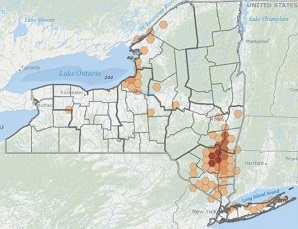Hunting and Trapping Newsletter
The New York State Department of Environmental Conservation sent this bulletin on 10/05/2021 11:24 AM EDT |
| DEC Delivers - Information to keep you connected and informed from the NYS Department of Environmental Conservation |
| Share or view as a web page || Update preferences or unsubscribe |
Hunting and Trapping Newsletter |
DEC Monitors EHD Range, But Does Not Anticipate Changes to Hunting SeasonMany hunters are aware that several counties in New York are experiencing an outbreak of Epizootic Hemorrhagic Disease this year, and some are concerned that the deer population cannot handle additional hunting harvest. Some hunters have inquired about the need for changes to the hunting season including curtailing the use of Deer Management Permits (DMPs; antlerless deer tags) in the affected areas. DEC appreciates this concern, but the current EHD outbreak does not justify such actions.
While several hundred dead deer in a county may seem like a lot, it’s a small fraction of the total deer population and a relatively minor number compared to what hunters generally harvest. For example, hunters typically harvest about 4,000 deer each year in Ulster County alone. Hunters may remember that NY also had an EHD outbreak in September last year. That outbreak resulted in roughly 1,500 dead deer in eight southeastern counties but was primarily concentrated in Putnam and Dutchess counties. DEC documented a reduction in the number of antlered deer subsequently harvested by hunters in Putnam County last season, but hunters there found and harvested antlerless deer at similar levels to previous years, despite the EHD outbreak. We didn’t see any evidence of EHD having an impact on the deer harvest in Dutchess, Greene, Orange, or other affected counties last year. Deer populations in the EHD-affected counties are very robust, and we expect them to recover to pre-outbreak levels quickly. Unfortunately, on individual properties most heavily impacted, landowners and hunters will likely see fewer deer for a couple years. We accounted for last year’s EHD outbreak when allocating DMPs this year. Likewise, we will continue to monitor the ongoing EHD situation and assess the impact in light of deer sighting rates and harvests reported by hunters. If we document a substantial reduction in the deer population that doesn’t align with population management objectives, we will adjust our future issuance of DMPs accordingly to curb population reduction. The good news is that this outbreak should be ending soon. The midges die with the first hard frost, which in southeastern NY generally occurs in early-mid October. To help us make deer management decisions using the best information, we encourage all hunters to submit reports of EHD-suspected deer that they find throughout the early hunting season through DEC’s online EHD reporting form, to participate in the bowhunter sighting log, and to report all deer that you harvest. |

 Headlines of a wildlife disease outbreak can be alarming, and it’s terrible when a landowner or hunter finds several dead deer, especially after they have been watching those deer all spring and summer. However, some perspective is needed to set the impact of EHD on deer populations in the appropriate context. DEC has received reports of roughly 1,150 dead deer from 20 counties, with the greatest number of reports coming from eastern Ulster County and to a lesser degree western Dutchess, Columbia, and Greene counties. For the other counties, we have received reports of only a handful to several dozen deer.
Headlines of a wildlife disease outbreak can be alarming, and it’s terrible when a landowner or hunter finds several dead deer, especially after they have been watching those deer all spring and summer. However, some perspective is needed to set the impact of EHD on deer populations in the appropriate context. DEC has received reports of roughly 1,150 dead deer from 20 counties, with the greatest number of reports coming from eastern Ulster County and to a lesser degree western Dutchess, Columbia, and Greene counties. For the other counties, we have received reports of only a handful to several dozen deer.